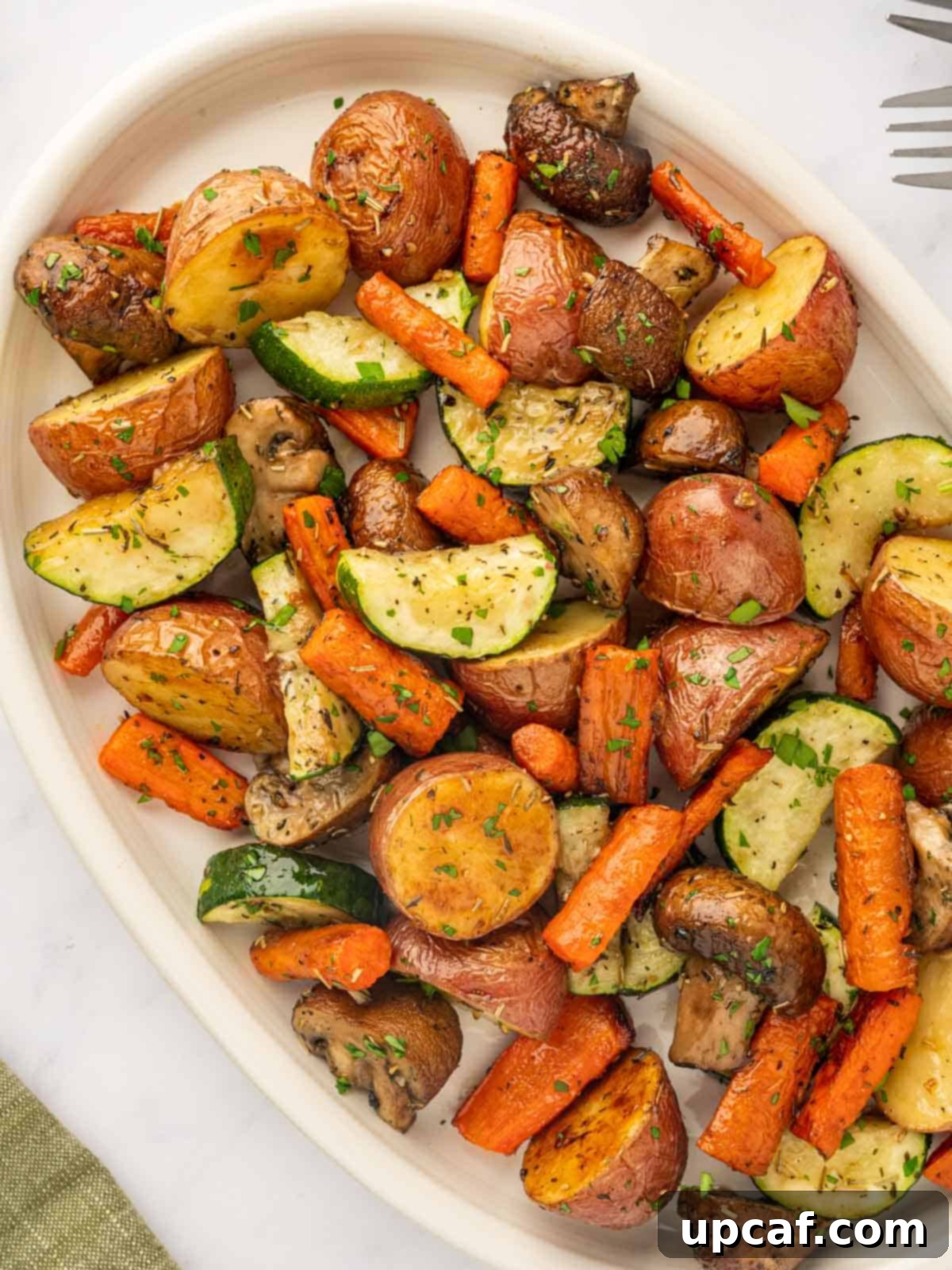Transform your meals with this incredibly simple, yet profoundly flavorful, medley of mixed roasted vegetables. Crowned with fragrant dried herbs and a touch of golden olive oil, this vibrant side dish effortlessly complements any main course. Boasting a delightful array of textures and deep, savory flavors, this recipe is a testament to culinary adaptability, ready to be customized to your taste and on your table in under an hour. It’s more than just a side; it’s an experience that celebrates the natural deliciousness of garden-fresh produce.
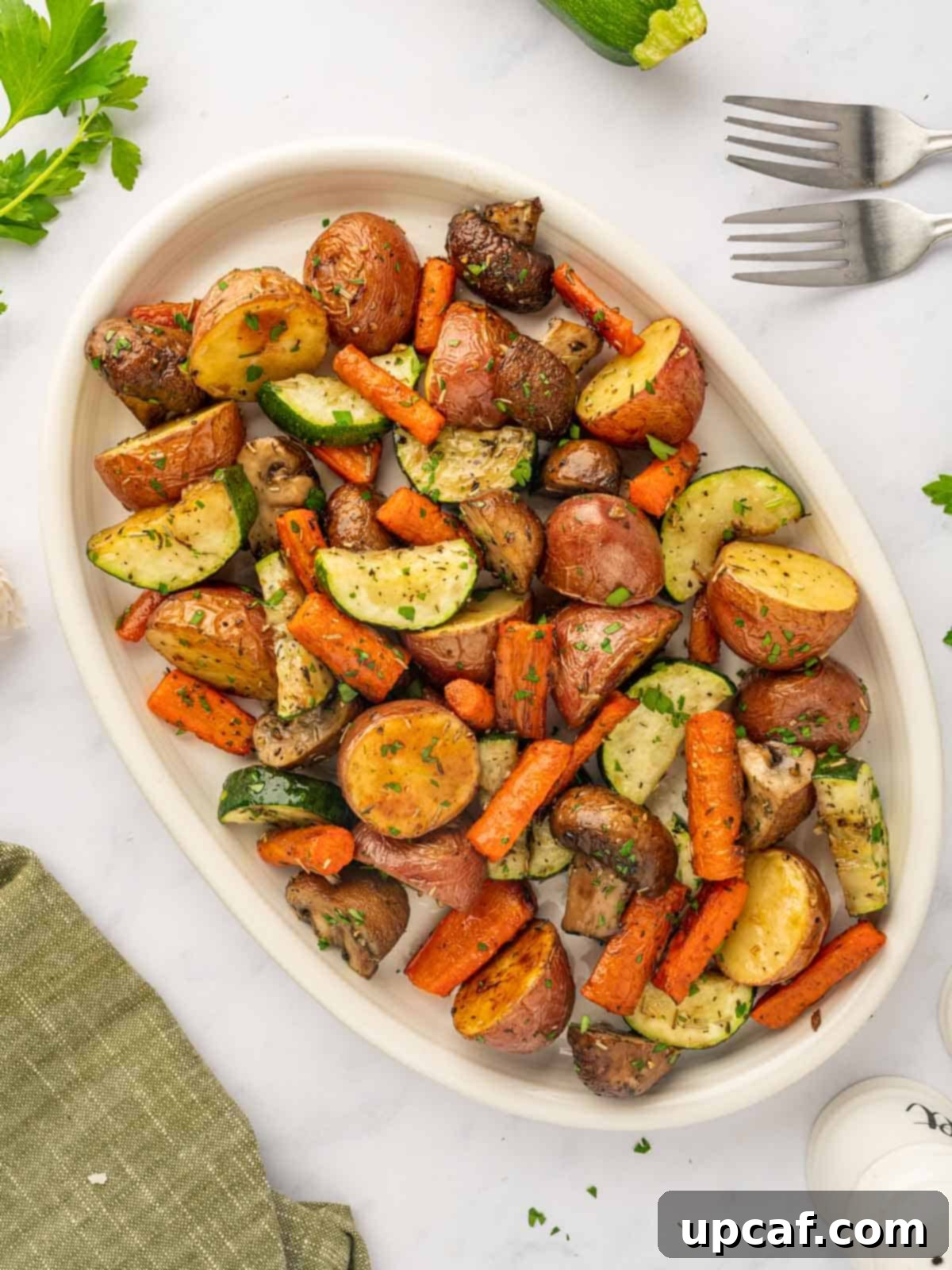
Oven-roasted vegetables, featuring a classic combination of tender potatoes, sweet carrots, succulent zucchini, and earthy mushrooms, create a dish that is as versatile as it is budget-friendly. This method of cooking elevates ordinary vegetables into something extraordinary, coaxing out their inherent sweetness and creating beautifully caramelized edges. The beauty of this recipe lies in its flexibility; feel free to incorporate your favorite seasonal produce or simply use up whatever vegetables you have on hand. The gentle yet intense heat of the oven brings out the best in each vegetable, resulting in a side dish that’s visually stunning and bursting with rich, complex flavors.
If you’re a connoisseur of crispy vegetables, you’ll also adore our Garlic Parmesan Green Beans or discover the satisfying crunch of our Crispy Oven Baked Onion Rings recipe.
Why You’ll Love This Roasted Vegetable Recipe
There are countless reasons why this easy mixed roasted vegetable recipe will become a staple in your kitchen. From its incredible versatility to its nutritional benefits, it’s a dish that truly delivers on all fronts.
- Unmatched Versatility: Roasted vegetables are the ultimate chameleon of the culinary world. They don’t just serve as a side dish; they can be the star of a light lunch, a vibrant addition to salads, a wholesome topping for grain bowls, or even a flavorful component in wraps and sandwiches. Their robust flavor profile means they pair beautifully with virtually any main entree, from roasted chicken and grilled fish to hearty steaks and plant-based protein dishes.
- Incredibly Budget-Friendly: In today’s world, maximizing your budget is key, and this recipe is a champion in cost-effectiveness. By utilizing seasonal produce, which is often more affordable, or simply clearing out those lingering vegetables in your fridge, you can create a satisfying and nutritious meal without breaking the bank. It’s an excellent way to minimize food waste while enjoying delicious, wholesome food.
- Perfect for Meal Prep: Save precious time during busy weekdays by incorporating this recipe into your meal prep routine. Roasted vegetables can be prepared in larger batches at the beginning of the week and stored for quick, healthy additions to multiple meals. They reheat beautifully, maintaining much of their flavor and texture, ensuring you have a convenient and nourishing option ready to go whenever hunger strikes.
- Flavor and Texture Perfection: The roasting process is a magical transformation. The high heat caramelizes the natural sugars in the vegetables, creating a delightful sweetness and a depth of flavor that steaming or boiling simply can’t achieve. You’ll get tender interiors with deliciously crispy, slightly charred edges that add an irresistible textural contrast to every bite.
- Health-Packed Goodness: This dish is a powerhouse of nutrition. Loaded with vitamins, minerals, and dietary fiber, roasted vegetables are an excellent way to boost your daily nutrient intake. Cooked with minimal oil, it’s a naturally healthy and wholesome addition to any diet, supporting overall well-being with every delicious serving.
Essential Ingredients for Perfectly Roasted Mixed Vegetables
Creating sensational roasted vegetables begins with selecting the right ingredients. Here’s a closer look at what you’ll need and why each component plays a crucial role in achieving that perfect medley of flavors and textures.
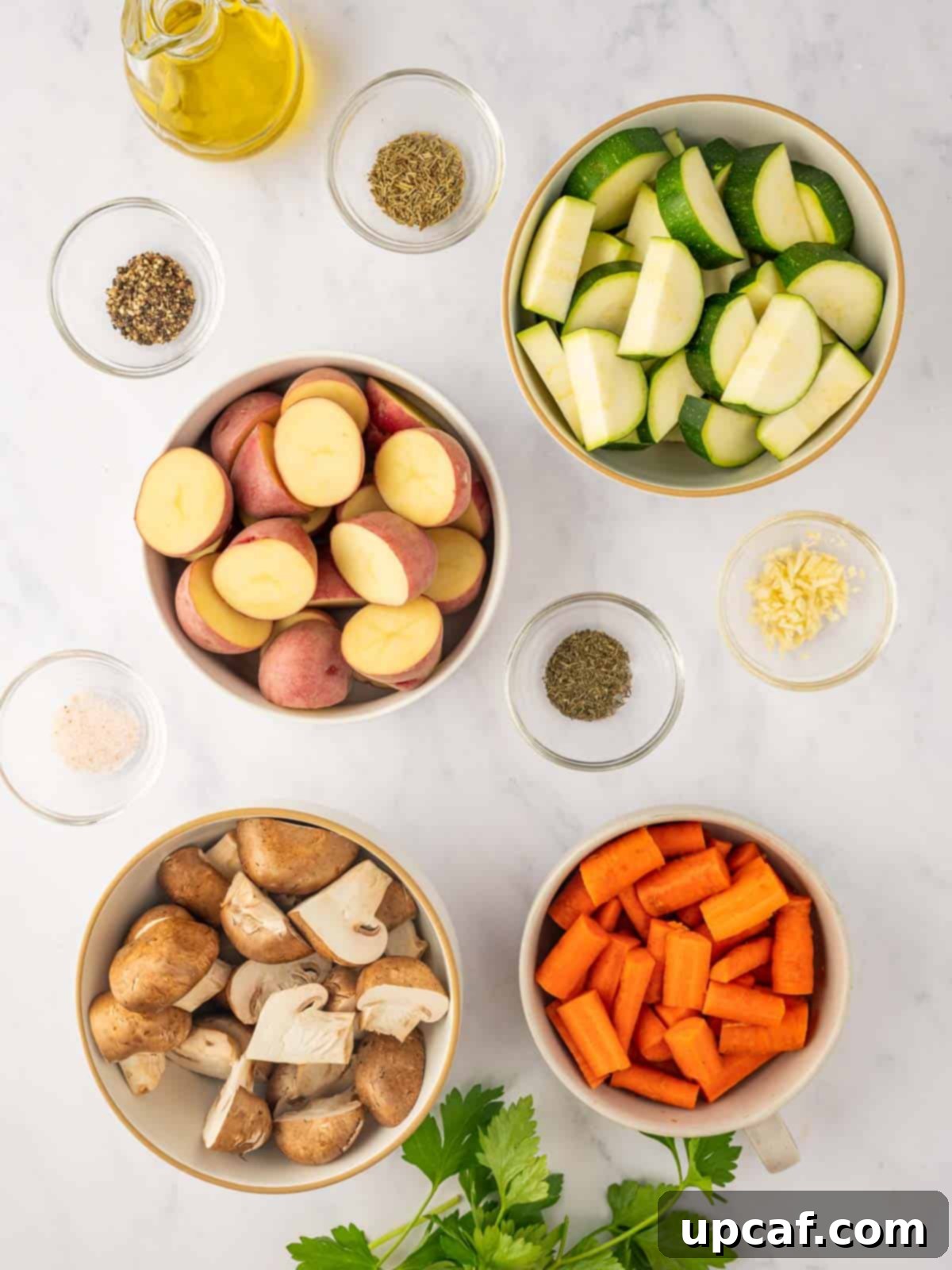
- Hearty Root Vegetables: Our foundation includes vibrant red baby potatoes and crisp carrots. These root vegetables are ideal for roasting due to their dense texture, which allows them to become wonderfully tender and slightly sweet without turning mushy. They also hold up well to the higher heat required for caramelization. Feel free to substitute with other root vegetables like sweet potatoes, parsnips, or even turnips for varied flavors and nutritional benefits.
- Tender Zucchini and Earthy Mushrooms: These additions bring a lighter texture and distinct umami notes to the dish. Zucchini becomes tender and slightly sweet, while mushrooms develop a rich, savory depth when roasted. If you’re looking to diversify, consider adding broccoli florets, cauliflower, bell peppers, asparagus, or even red onions. These vegetables generally cook faster, which is why we add them later in the roasting process.
- Aromatic Herbs: Dried thyme and rosemary are the stars of our seasoning blend, infusing the vegetables with a deep, savory, and wonderfully fragrant essence. Their woody, pungent notes beautifully complement the sweetness of the root vegetables. Fresh parsley, added at the end, not only provides a pop of vibrant color but also a fresh, herbaceous finish that brightens the entire dish. Don’t hesitate to adjust these to your palate; dried oregano, marjoram, or even a touch of sage can also be excellent choices.
- Essential Spices: Minced garlic offers an indispensable aromatic foundation, contributing a warm, pungent flavor that is quintessential to savory dishes. Alongside, salt and freshly ground black pepper are crucial for enhancing and balancing the natural flavors of all the vegetables. For an extra layer of complexity, consider a pinch of paprika for color and mild heat, or onion powder to deepen the savory notes.
- Quality Olive Oil: The right oil is key to achieving that perfect golden-brown crispness. Olive oil not only helps conduct heat to cook the vegetables evenly but also contributes to their luscious texture and rich flavor. Choose a good quality extra virgin olive oil for its nuanced taste, or a lighter, neutral-flavored oil if you prefer the vegetable flavors to shine unadulterated. The oil ensures a beautiful sear and prevents sticking to the baking sheet.
How To Cook The Perfect Mixed Roasted Vegetables
Follow these simple steps to create a show-stopping platter of perfectly roasted vegetables. The secret lies in strategic timing and proper seasoning to ensure every vegetable reaches its optimal tenderness and caramelization.
Step 1: Prepare Your Oven and Baking Sheet. Begin by preheating your oven to a consistent 400 degrees Fahrenheit (200 degrees Celsius). This high temperature is crucial for achieving that desirable crisp exterior and tender interior. While the oven heats, line a large baking sheet with parchment paper. This simple step prevents sticking and makes for effortless cleanup, ensuring your vegetables roast rather than stew.
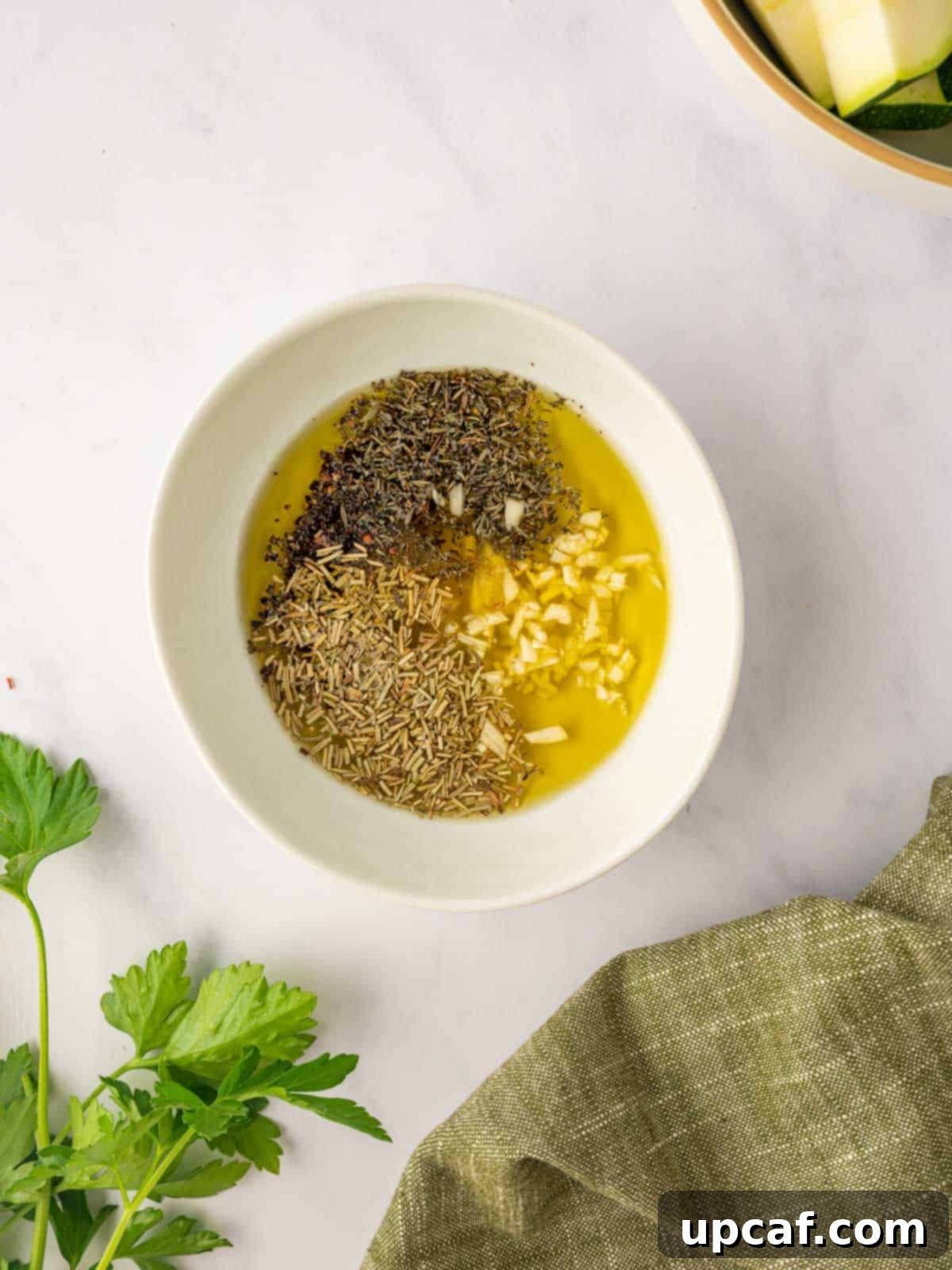
Step 2: Craft Your Flavorful Seasoning Blend. In a small bowl, combine the olive oil, minced garlic, salt, ground black pepper, dried rosemary, and dried thyme. Whisk these ingredients together until they are thoroughly blended. This fragrant oil mixture will be the backbone of your vegetables’ flavor, ensuring every bite is rich and aromatic. Set this mixture aside, allowing the flavors to meld.
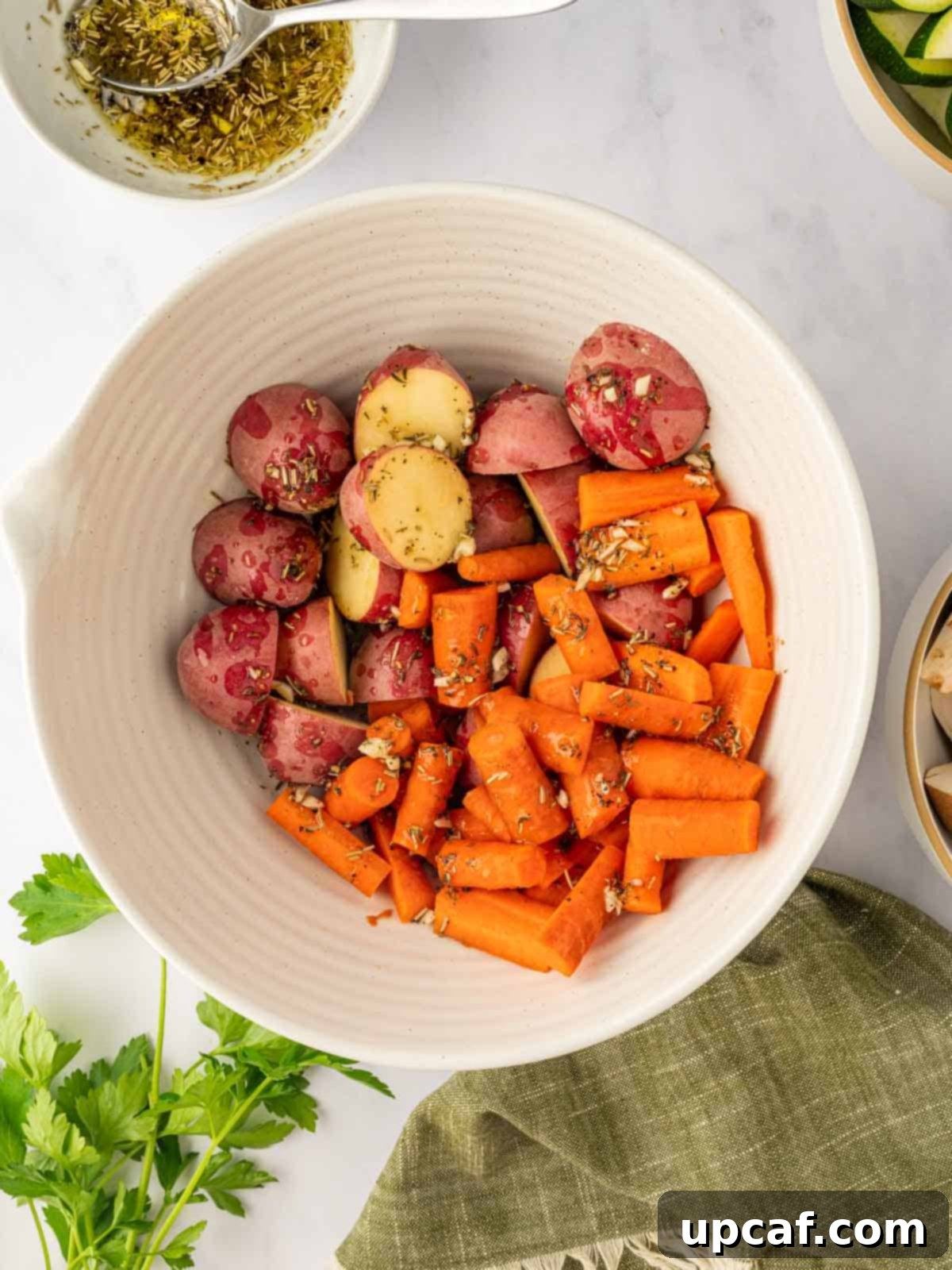
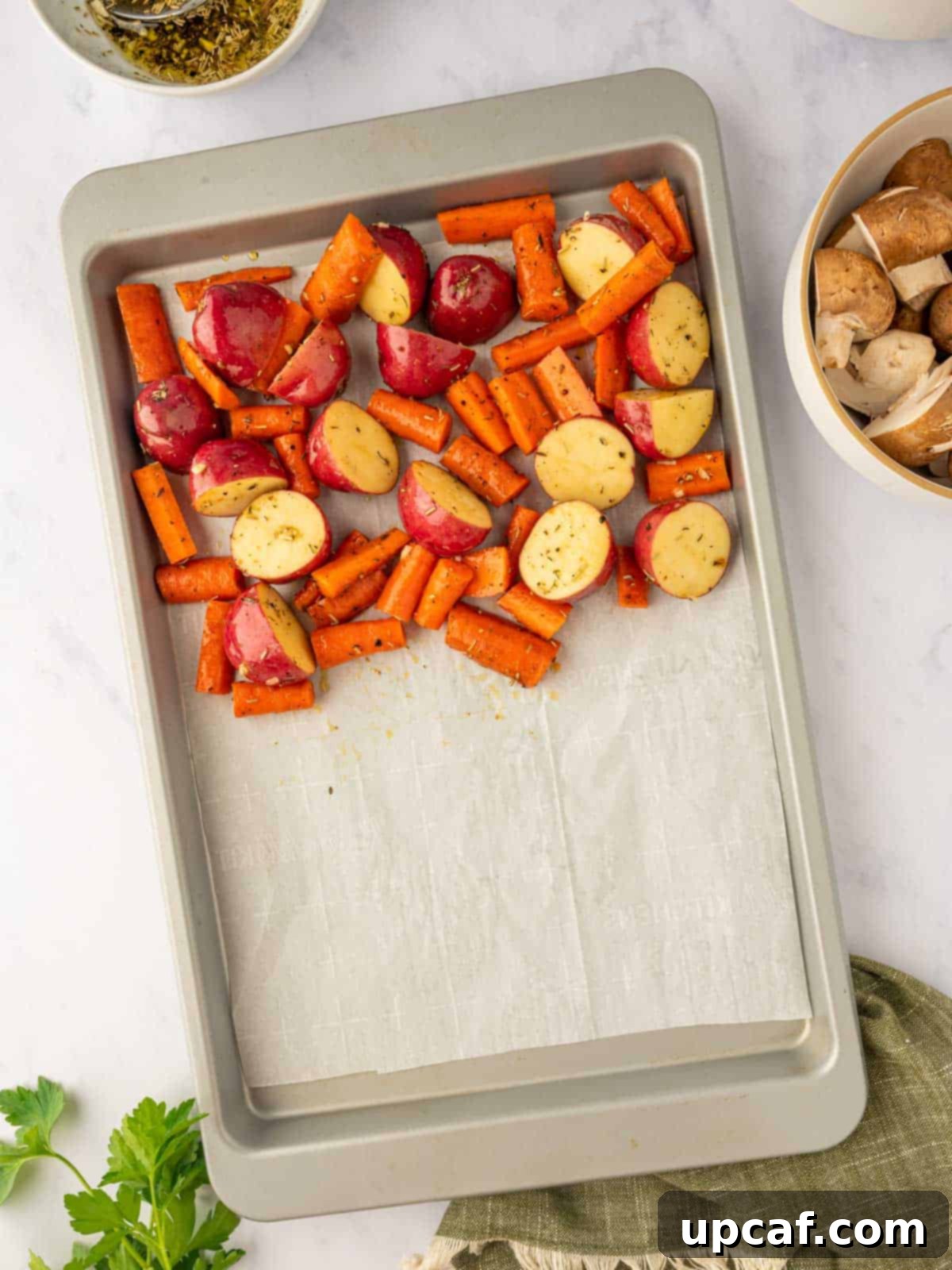
Step 3: Begin Roasting the Root Vegetables. In a large mixing bowl, add your prepared red baby potatoes and carrots. Pour approximately half of the olive oil and herb mixture over them. Toss vigorously until every piece is evenly coated. This ensures consistent flavor and optimal caramelization. Carefully transfer the coated root vegetables to your prepared baking sheet, spreading them in a single layer without overcrowding. Place the baking sheet into the preheated oven and roast for an initial 20 minutes. This head start is essential because denser vegetables like potatoes and carrots require more cooking time.
Step 4: Marinate the Quicker-Cooking Vegetables. While the root vegetables are roasting, return to the same large mixing bowl (no need to wash it!). Add the sliced cremini mushrooms and zucchini. Pour the remaining oil and herb mixture over these vegetables and toss thoroughly until they are uniformly coated. Allowing them to marinate slightly while the first batch cooks infuses them with flavor.

Step 5: Combine and Continue Roasting. After the initial 20 minutes, carefully remove the baking sheet from the oven. Gently add the marinated mushrooms and zucchini to the unoccupied spaces on the baking sheet, ensuring they are also in a single layer alongside the partially roasted potatoes and carrots. If necessary, you can lightly toss all the vegetables together on the sheet to redistribute them for even cooking.
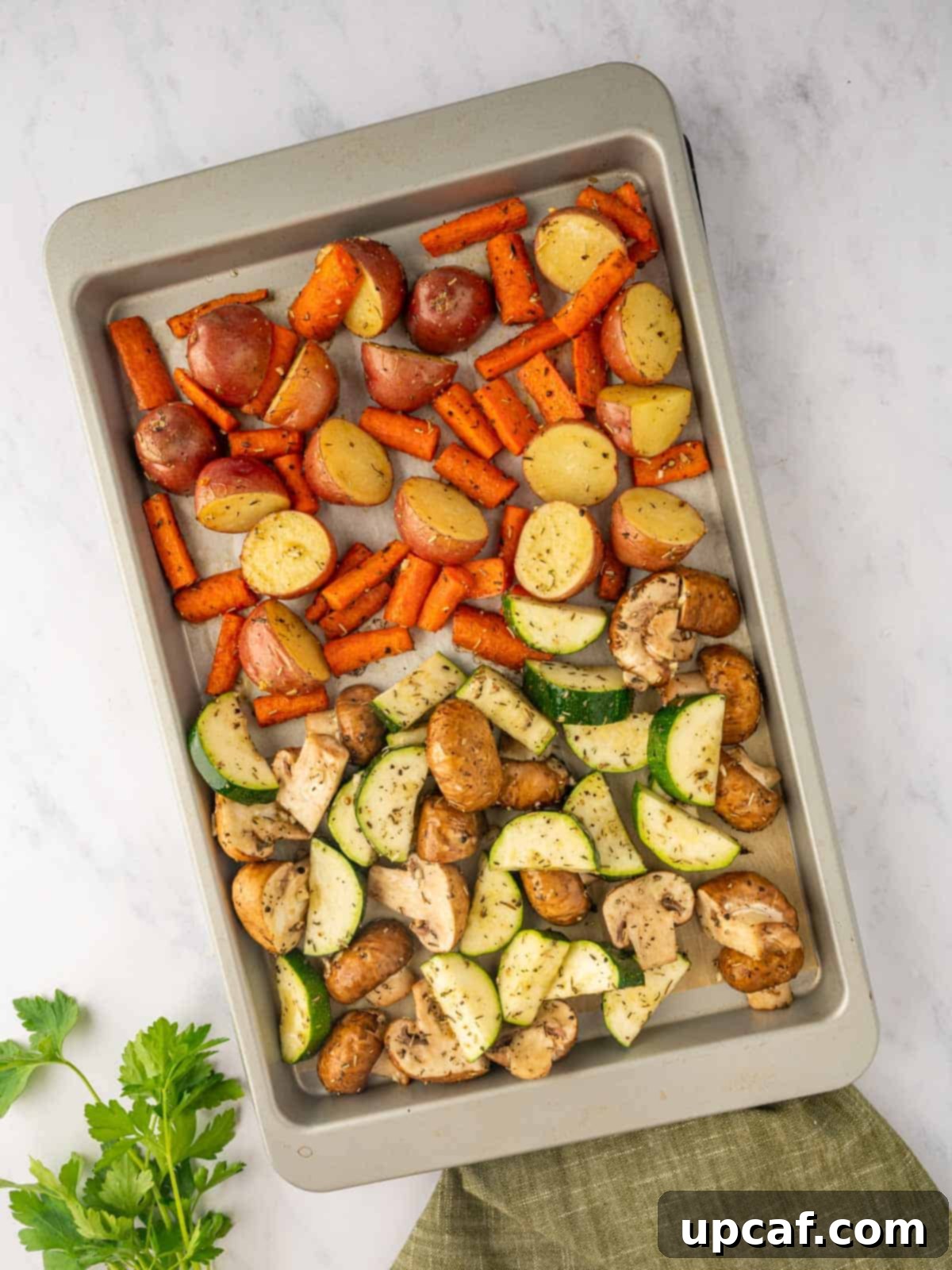
Step 6: Finish Roasting to Perfection. Return the baking sheet to the 400-degree F oven and continue roasting for another 18-20 minutes. During this final stage, the root vegetables will become fully tender, and all the vegetables will achieve beautiful caramelization and a slight crispness around the edges. Keep an eye on them, and if desired, gently toss them halfway through this stage for more even browning.
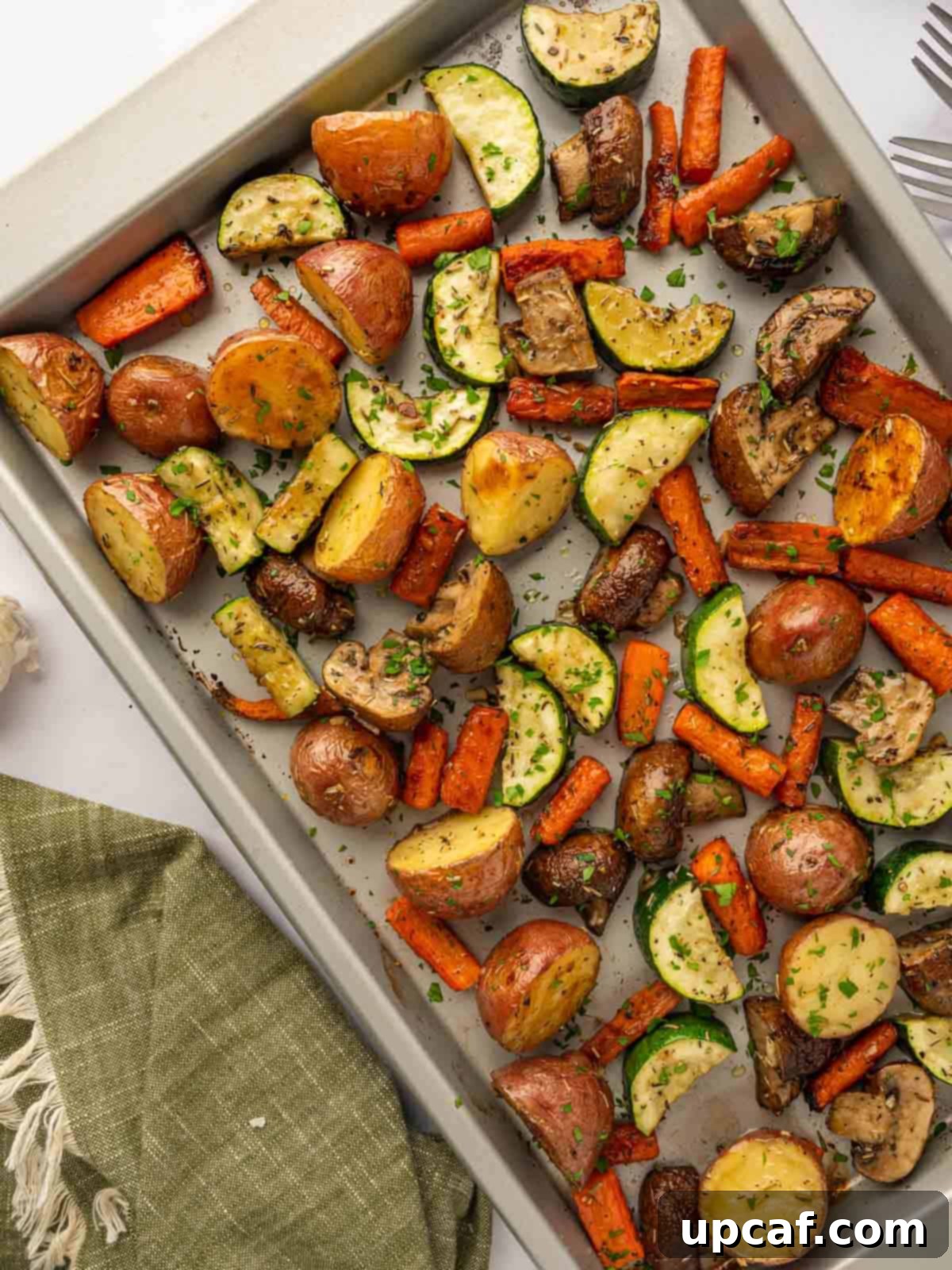
Step 7: Garnish and Serve Immediately. Once your roasted vegetables are perfectly tender and golden, remove the baking sheet from the oven. Transfer them to a serving platter and generously sprinkle with fresh, finely chopped parsley. The fresh herbs add a final layer of freshness and a touch of elegance. Serve this colorful and delicious medley immediately as a delightful side to your favorite meal.
Expert Tips for Flawless Roasted Vegetables
Achieving perfectly roasted vegetables is an art form that’s easy to master with a few key techniques. Follow these expert tips to ensure your vegetables are always tender on the inside, crispy on the outside, and bursting with flavor.
- Ensure Evenly Sized Pieces: This is perhaps the most crucial tip for uniform cooking. Cut all your vegetables into roughly the same size and shape. If you have a mix of dense vegetables (like potatoes and carrots) and quicker-cooking ones (like zucchini and mushrooms), adjust their sizes accordingly. Larger cuts for softer veggies, smaller cuts for harder ones, or follow our two-stage roasting method. This prevents some vegetables from burning while others remain undercooked.
- Always Preheat the Oven Thoroughly: Don’t rush this step! A properly preheated oven is essential for optimal caramelization and crispiness. Placing vegetables into a cold or lukewarm oven will cause them to steam rather than roast, resulting in a soggy texture. High, consistent heat is what creates those desirable browned, crispy edges and tender interiors.
- Utilize a Large Baking Sheet and Avoid Overcrowding: Give your vegetables room to breathe! Spread them out in a single layer on a large baking sheet, ensuring there’s space between each piece. Overcrowding the pan causes vegetables to release moisture, which then creates steam. This steaming effect prevents the vegetables from browning and becoming crispy. If necessary, use two baking sheets to accommodate all your vegetables.
- Don’t Skimp on the Oil (But Don’t Drown Them): Oil is vital for transferring heat, preventing sticking, and promoting browning. Use enough oil to lightly coat all surfaces of the vegetables. Too little oil will result in dry, scorched spots, while too much can make them greasy. A good rule of thumb is about 1-2 tablespoons of oil per pound of vegetables.
- Roast at the Right Temperature: For most vegetables, a temperature between 400-425°F (200-220°C) is ideal for roasting. This high heat is what encourages the Maillard reaction (browning) and caramelization, leading to deep, complex flavors.
- Season Generously: Don’t be shy with your seasonings! Vegetables can absorb a lot of flavor. Apply salt, pepper, and herbs evenly. Consider seasoning in stages – once when you toss with oil, and again lightly after roasting, especially with fresh herbs.
- Turn or Toss Halfway: For even browning and consistent texture, give your vegetables a good stir or flip them halfway through the cooking time. This exposes all sides to the direct heat of the baking sheet, ensuring every piece gets its turn to crisp up.
- Check for Doneness: Vegetables are perfectly roasted when they are fork-tender and have developed rich golden-brown spots and caramelized edges. The exact cooking time will vary based on the type of vegetable and the size of your cuts, so trust your judgment and taste!
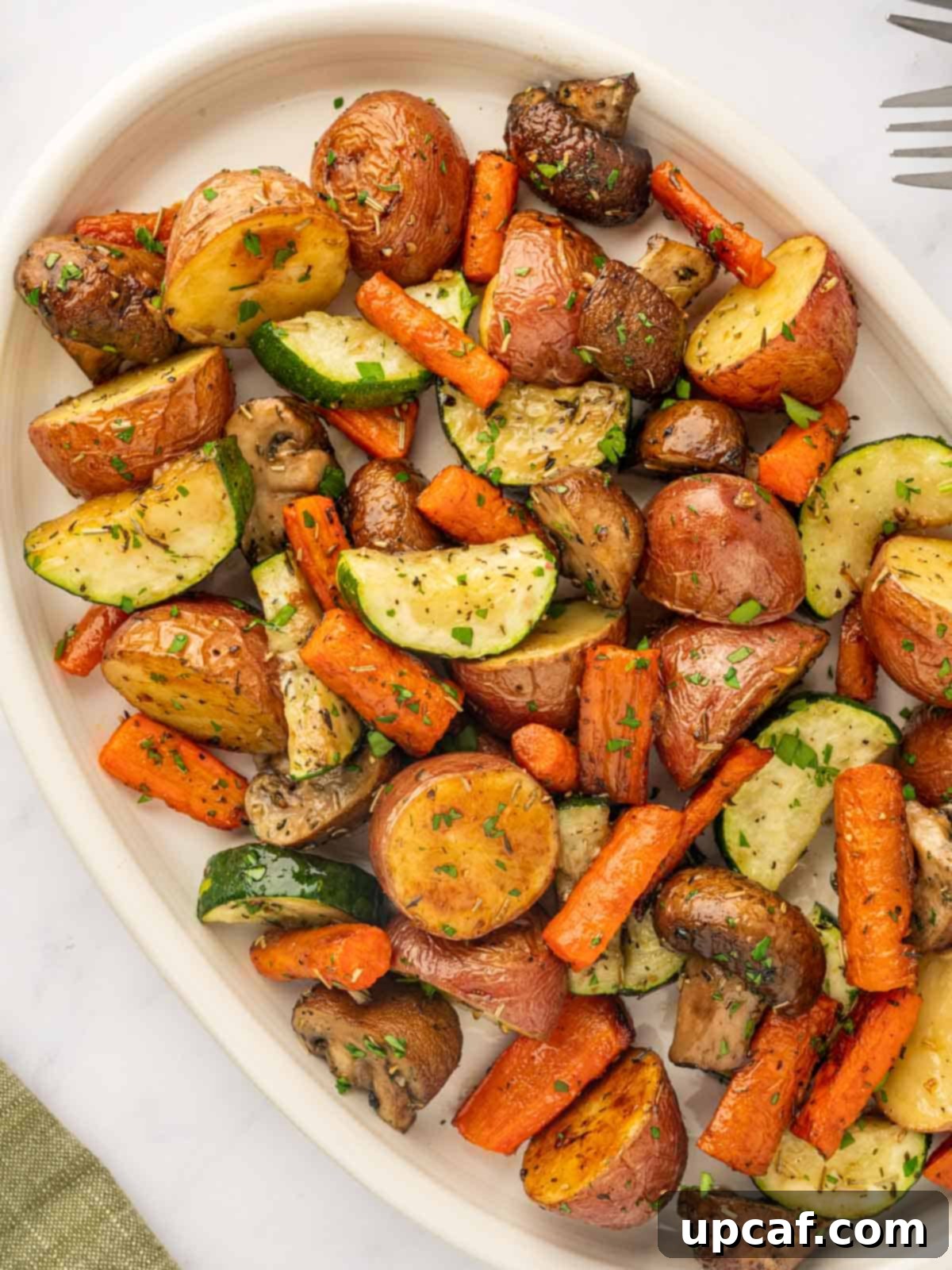
Storing and Reheating Roasted Vegetables
Proper storage and reheating techniques are key to enjoying your delicious roasted vegetables long after they’re fresh out of the oven.
- Storing: Allow the roasted vegetables to cool completely before transferring them to an airtight container. Store them in the refrigerator for 3-5 days. This method helps maintain their quality and prevents bacterial growth.
- Reheating: To bring back some of their crispness, the best method for reheating is often in the oven or a skillet. Spread the vegetables on a baking sheet and broil them briefly until warmed through and crisped up, or toss them in a hot skillet over medium-high heat for a few minutes. While the microwave works for convenience, it tends to make them softer and less desirable in texture.
- Freezing: While technically possible, freezing roasted vegetables is generally not recommended. The high water content in most vegetables means they will become quite soggy and lose their pleasant texture upon thawing, often resulting in an unpleasant experience. It’s best to enjoy them fresh or within their refrigerated shelf life.
Alternative Cooking Methods for Your Favorite Vegetables
While oven roasting is fantastic, there are several other excellent ways to prepare your favorite vegetables, each offering a unique flavor and texture profile.
- Grilling: For a delicious smoky flavor and beautiful charred edges, grilling is an excellent choice. Simply toss your cut vegetables with oil, salt, pepper, and your preferred seasonings. Grill them over medium-high heat, turning occasionally, until they are tender and marked with appealing grill lines. Using a grill basket or skewers can help prevent smaller pieces from falling through the grates. This method works wonderfully for bell peppers, onions, zucchini, asparagus, and even heartier root vegetables.
- Air Frying: If you crave crispy exteriors with significantly less oil, the air fryer is your best friend. Toss the vegetables with just a small amount of oil and seasonings, then arrange them in a single layer in the air fryer basket. Cook at about 400 degrees Fahrenheit (200 degrees Celsius) until they turn golden brown and tender, remembering to shake the basket every 5-7 minutes for even cooking. This is particularly great for broccoli, cauliflower, Brussels sprouts, and potatoes.
- Sautéing: For a quicker cooking method, sautéing in a skillet can yield beautifully caramelized and tender vegetables. Heat your skillet to medium-high with a tablespoon or two of oil. Add denser root vegetables first, cooking until they start to soften, then introduce quicker-cooking vegetables like zucchini and mushrooms. Cook, stirring frequently, until all vegetables are caramelized and browned to your liking. This method is perfect for a fast weeknight side.
- Steaming: If you’re looking for a lighter, more delicate texture and want to preserve maximum nutrients, steaming is an excellent option. While it won’t produce the crispy texture of roasting or grilling, it results in vibrant, tender vegetables. Simply place vegetables in a steamer basket over boiling water and cook until they reach your desired tenderness. Finish with a drizzle of olive oil, a squeeze of lemon, and a sprinkle of salt and pepper.
What to Serve with Roasted Vegetables
Roasted vegetables are truly the quintessential side dish, enhancing nearly any main course with their rich flavor and appealing texture. They are incredibly versatile and pair beautifully with a wide array of proteins and other dishes. Consider serving them with:
- Poultry: Our Oven Chicken Skewers or Mediterranean Roasted Chicken.
- Fish: Pair them with Baked Herb Crusted Cod, Baked Thai Salmon, or Air Fryer Mahi Mahi.
- Other Proteins: Grilled steak, lamb chops, pork tenderloin, or even plant-based options like baked tofu or tempeh.
- Grain Bowls & Salads: Add a hearty scoop of roasted veggies to warm quinoa or rice bowls, or toss them into a vibrant green salad for extra flavor and substance.
- Pasta: They make an excellent mix-in for pasta dishes, especially with a light olive oil or pesto sauce.
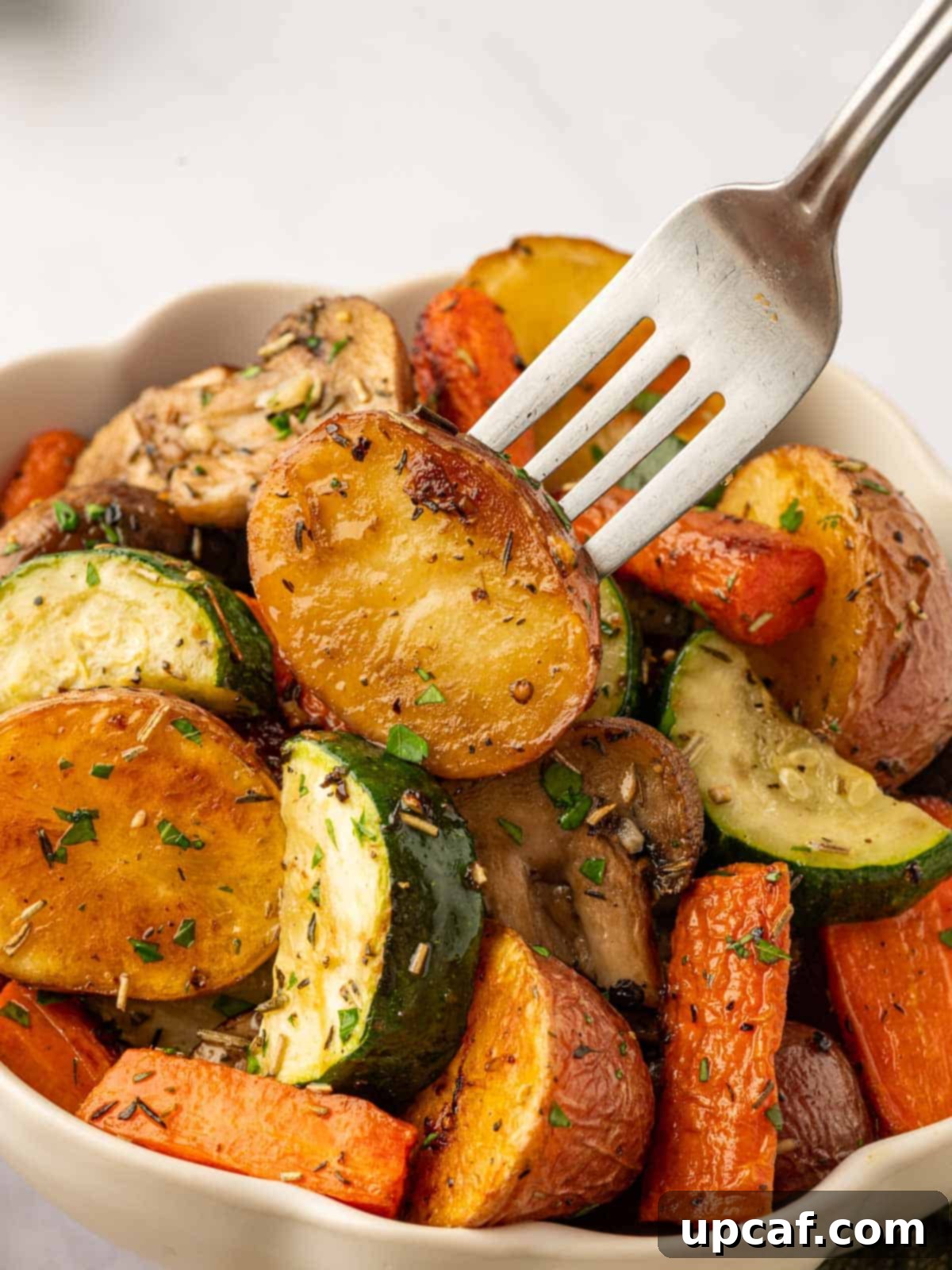
Frequently Asked Questions About Roasted Vegetables
Peeling vegetables before roasting is largely a matter of personal preference and the type of vegetable. For root vegetables like potatoes and carrots, peeling is optional; their skins can get wonderfully crispy and are packed with nutrients. However, if you prefer a smoother texture or if the skins are particularly thick or bruised, feel free to peel them. For vegetables like zucchini, bell peppers, or mushrooms, peeling is generally unnecessary and can even detract from their texture and presentation.
The best seasonings for roasted vegetables often depend on your personal taste and the cuisine you’re aiming for. A universal base includes olive oil, salt, and freshly ground black pepper. Beyond that, minced garlic, garlic powder, onion powder, and paprika are popular choices that add depth. For herbs, dried rosemary, thyme, and oregano are classic and robust. You can also explore options like Herbs de Provence, cumin, chili powder, or even a dash of red pepper flakes for a little kick. Don’t be afraid to experiment with different flavor combinations to find your favorites!
Leftover roasted vegetables can be stored in an airtight container in the refrigerator for up to 3-4 days. For best results in terms of texture, allow them to cool completely before storing. While they won’t retain their initial crispiness as well, they remain delicious and convenient for quick meals throughout the week. Reheat them in the oven or a skillet for the best texture, or simply warm them in the microwave if convenience is your priority.
The secret to truly exceptional roasted vegetables lies in a few key practices: Firstly, ensure all your vegetables are cut into evenly sized pieces for uniform cooking. Secondly, avoid overcrowding the baking pan; giving vegetables space allows them to roast and caramelize rather than steam. Thirdly, group similar vegetables with comparable cooking times together or add denser vegetables earlier, as demonstrated in this recipe. Root vegetables generally require more time in the oven, so start them first before introducing quicker-cooking varieties like zucchini and mushrooms. Finally, a hot oven (400°F/200°C or higher) and a good coating of oil are essential for achieving that desirable golden-brown exterior and tender interior.
Absolutely! This recipe is incredibly adaptable. Feel free to mix and match your favorite vegetables or use whatever is fresh and in season. Excellent additions or substitutions include broccoli, cauliflower, Brussels sprouts, bell peppers (any color), red onions, asparagus, green beans, or even cherry tomatoes. Remember to adjust cutting sizes and roasting times based on the density of the vegetables; denser ones will need more time, while softer ones will cook quickly.
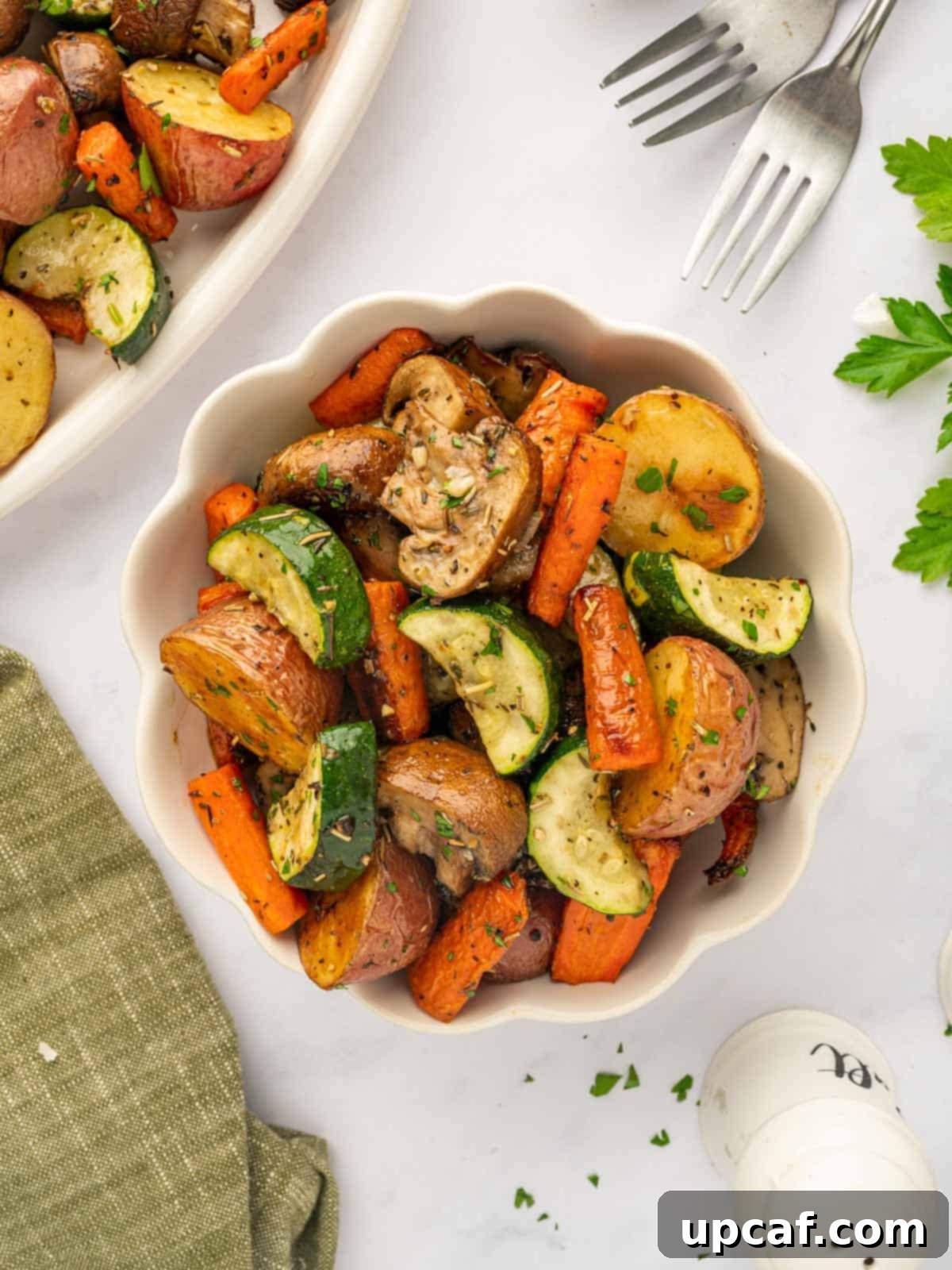
More Delicious Vegetable Recipes
If you’ve enjoyed this roasted vegetable medley, be sure to explore more of our delightful vegetable-centric recipes:
- Parmesan Roasted Glazed Carrots: Sweet, savory, and irresistible.
- Homemade Green Bean Casserole: A comforting classic with a fresh twist.
- Air Fryer Parmesan Asparagus: Quick, crispy, and incredibly flavorful.
- Air Fryer Zucchini Sticks: A healthy and satisfying snack or side.
- Air Fryer Sliced Potatoes: Perfectly crispy potatoes with minimal effort.
It’s time to elevate your vegetable game with our incredibly easy and satisfying mixed roasted vegetable recipe. With minimal effort and maximum flavor, this versatile dish is perfect for any occasion and is sure to please even the pickiest eaters. Enjoy the simplicity and the delicious results!
If you try this recipe or any of my other recipes, please leave a star rating in the comment section below. Also follow me at Cookin’ With Mima on Facebook |Instagram |Pinterest for all of my latest social posts and recipes.
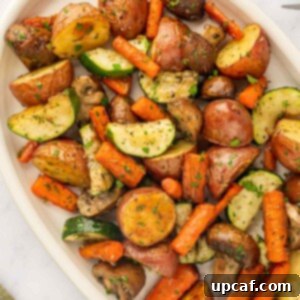
Easy Mixed Vegetables
Ingredients
- 4 tablespoons olive oil
- 1 tablespoon minced garlic
- 1 teaspoon salt
- 1 teaspoon ground black pepper
- ½ teaspoon dried rosemary
- ½ teaspoon dried thyme
- 1 lb red baby potatoes, cut into halves
- 4 medium carrots, scrubbed and cut into 2 inch size
- 8 oz cremini mushrooms, cut into halves
- 2 medium zucchini, cut into 1 inch size
- 2 tablespoons fresh parsley, finely chopped
Instructions
- Preheat the oven to 400 degrees F. Line a baking sheet with parchment paper and set it aside.
- In a small bowl, combine olive oil, garlic, salt, pepper, rosemary, and thyme. Mix well and set aside.
- In a large bowl, add the potatoes and carrots. Pour half of the prepared olive oil mixture and toss well until evenly coated. Transfer them to the prepared baking sheet and bake for 20 minutes.
- Meanwhile, to the same large bowl, add the mushrooms and zucchini. Pour the remaining oil mixture and toss well until well coated.
- After 20 minutes, remove the baking sheet from the oven and add the mushrooms and zucchinis on the other side with the potatoes and carrots.
- Roast the veggies in the oven again for 18-20 minutes at 400 degrees F until tender.
- Once done, sprinkle fresh parsley over the roasted veggies and serve.
Notes
- Evenly Sized Pieces: Cut the vegetables into uniform sizes to ensure even cooking.
- Preheat the Oven: Make sure the oven is preheated before roasting the vegetables for optimal caramelization.
- Use a Large Baking Sheet: Spread the vegetables out in a single layer on a large baking sheet to prevent overcrowding and ensure proper roasting.
Nutrition
Like this recipe? Rate and comment below!
